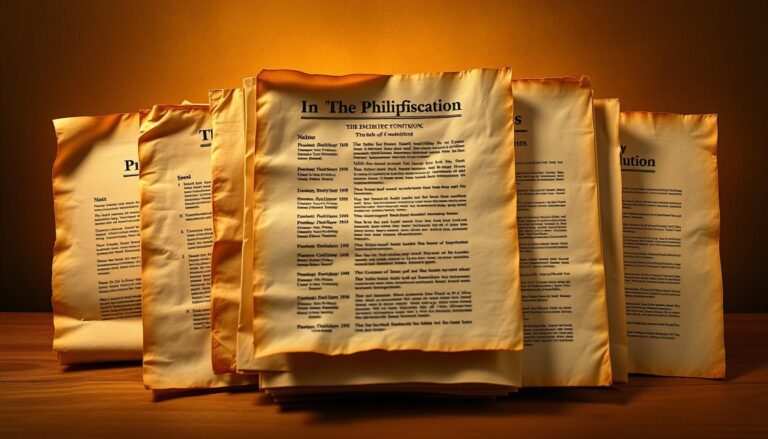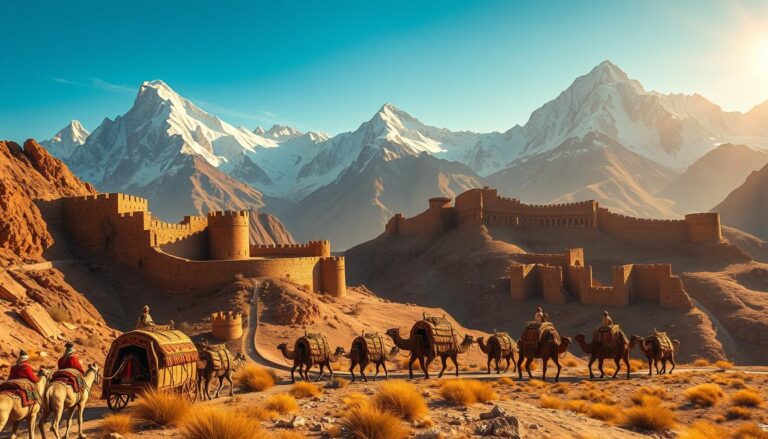History of Filipino Migration: A Global Journey
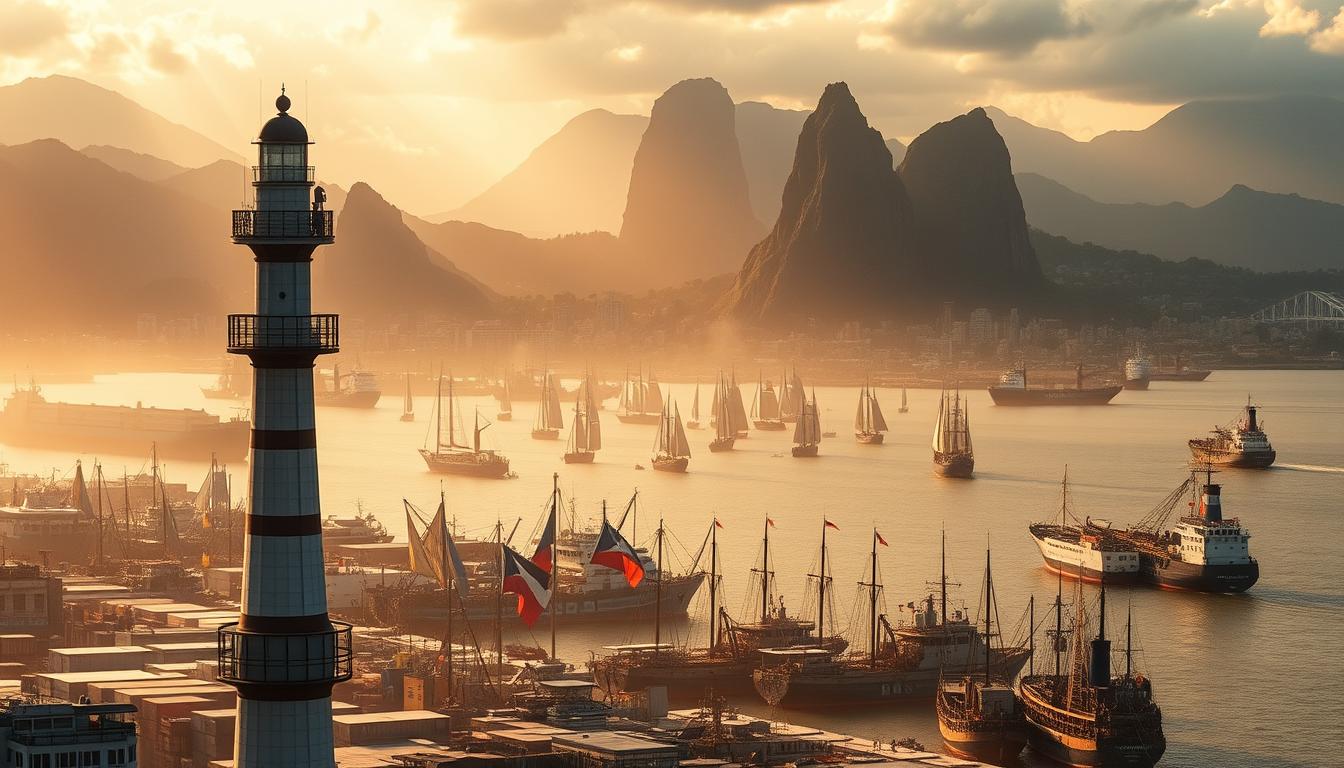
The story of Filipino migration is one of strength and change over many years. From before the Spanish came to today, Filipinos have traveled the world. They have made the Filipino diaspora what it is now.
The way Filipinos move around the world has changed a lot. It now helps both those who go away for a short time and those who stay for good. There are special groups like the Philippine Overseas Employment Administration and Overseas Workers Welfare Administration to help them.
Now, almost 10 million Filipinos live outside the Philippines. They make up about 10% of the country’s people. Their work sends back $33.5 billion in 2023. This movement of Filipinos is changing both their home country and the places they now live.
Early Waves of Migration from the Philippines
Filipino migration patterns go back thousands of years. They have shaped the diverse culture of the Philippines. The first waves of Filipino immigration started long before we had records.
Pre-Colonial Migration Patterns
The first humans reached the Philippines about 250,000 years ago. They were called “Dawn Man” and were similar to Homo erectus found in Southeast Asia. Over time, more groups came, each adding something new to the islands’ culture.
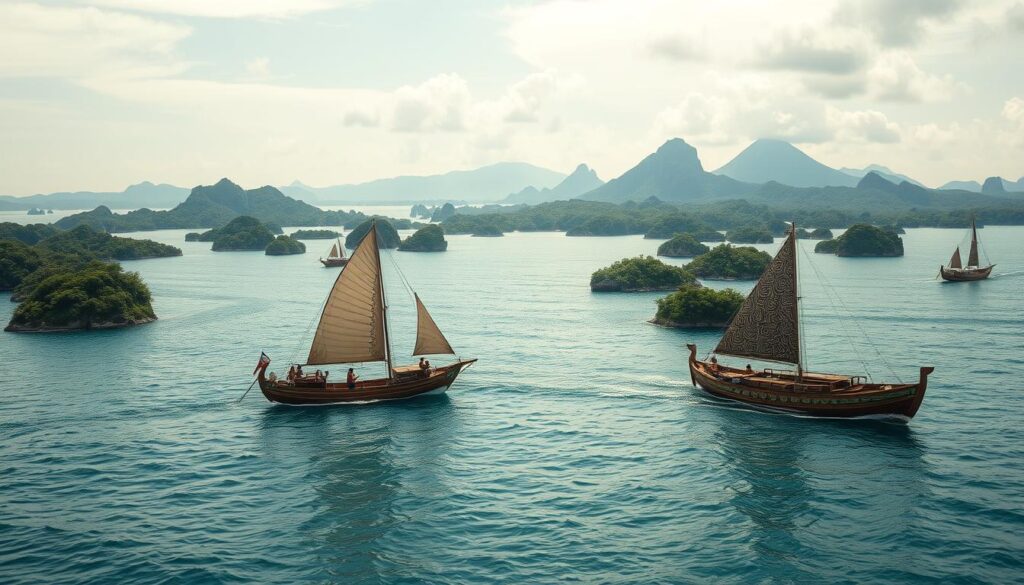
Then, around 30,000 years ago, the Negritos arrived. They crossed land bridges during the Pleistocene period. Later, about 6,000 years ago, seafaring Indonesians came. They brought advanced stone tools and farming methods.
Trade Relations with Neighboring Regions
About 3,000 years ago, the Malays arrived. They brought Iron Age technology, changing the culture and economy. This time also saw the start of trade with nearby areas, affecting migration.
These early migrations set the stage for the Philippines’ rich culture today. The mix of different groups and traditions formed a unique Filipino identity. This identity has grown through centuries of trade, colonization, and global interactions.
Spanish Colonial Era and Migration
The Spanish colonial era was a big change for Filipino migration. From 1565 to 1898, many Spanish came to the Philippines. They changed the country’s people and set the stage for Filipino-American history.
Impact of Spanish Rule on Filipino Movement
Spanish rule changed how Filipinos moved around. New cities like Manila and Cebu became centers for people to go to. The encomienda system made many Filipinos move, and Spanish rules encouraged mixed marriages.
By the late 1700s, many Filipinos had Spanish blood:
| Region | Spanish Filipino Population |
|---|---|
| Tondo (Manila) | 19% |
| Bataan | 16.72% |
| Cebu | 2.17% |
| Ilocos | 1.38% |
The Galleon Trade and Its Influence
The Manila galleon trade was key for early Filipino migration. It connected the Philippines to Mexico, leading to cultural exchange and migration. In 1763, Filipino Americans started their first North American settlement in St. Malo, Louisiana, after escaping forced labor during the galleon trade.

From 1763 to 1906, Filipino sailors and adventurers went to the West Coast, Hawaii, and Alaska. They looked for jobs in fishing and whaling. These early immigrants faced racism but helped build Filipino-American communities.
The American Period and Migration Changes
The American colonial era brought big changes to Filipino immigration. Thousands of Filipinos moved to the United States for new chances and jobs.
New Opportunities Under American Rule
American rule opened new doors for Filipinos. By 1900, over 5,600 Filipinos lived in California and 3,400 in Washington. From 1906 to 1932, more than 150,000 Filipinos came to the U.S.
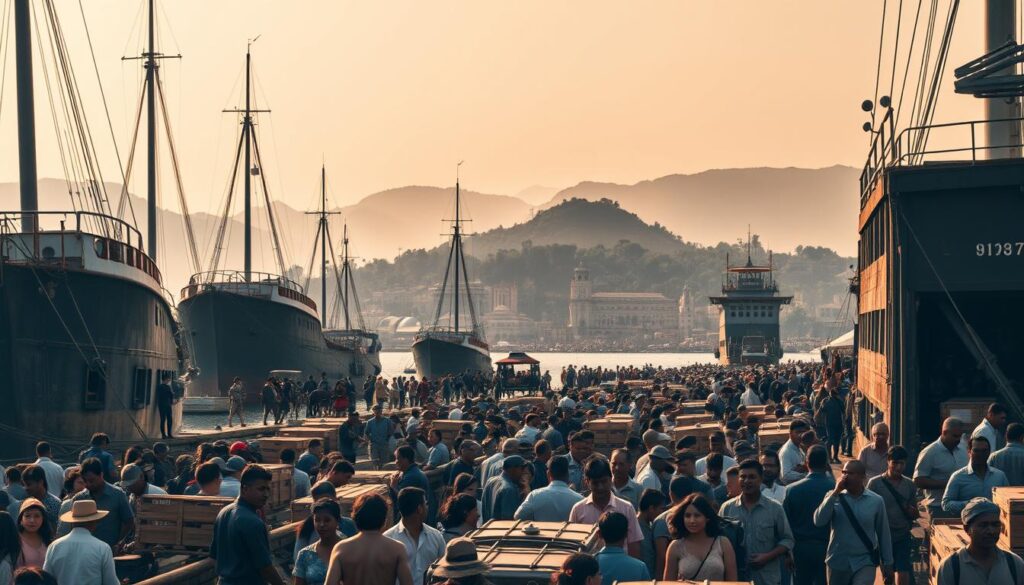
The Emergence of Labor Migration
Labor migration became a big part of Filipino immigration then. Many found work in Hawaii’s sugar plantations. This trend lasted until 1935, when laws and the Great Depression slowed migration.
Despite these challenges, Filipino immigration kept going. From 1946 to 1965, over 34,000 Filipinos came to the U.S. The Luce-Celler Act of 1946 allowed 100 Filipinos to immigrate each year, but more came.
By 1965, a new chapter in Filipino-American history started. Over 800,000 Filipinos immigrated to the U.S. in the next 20 years.
Post-World War II Filipino Migration Trends
After World War II, Filipino migration patterns changed a lot. New immigration rules and economic plans led to more Overseas Filipino Workers (OFWs). This changed the future of Filipino labor migration.
Changes in Immigration Policies
After the war, immigration rules in many countries affected Filipino migration. The United States, a big destination before, had new rules. These rules made it harder for Filipinos to go there.
This led Filipinos to look for other places to work.
| Destination Country | Percentage of Filipino Migrants (2011) |
|---|---|
| United States | 39% |
| Canada | 34% |
| United Kingdom | 15% |
| Australia | 5% |
| Italy | 3% |
Growth of Overseas Filipino Workers
In the 1970s, more Filipinos went abroad to work. President Ferdinand Marcos made sending workers abroad a key plan. This led to more OFWs going to the Middle East and East Asia.
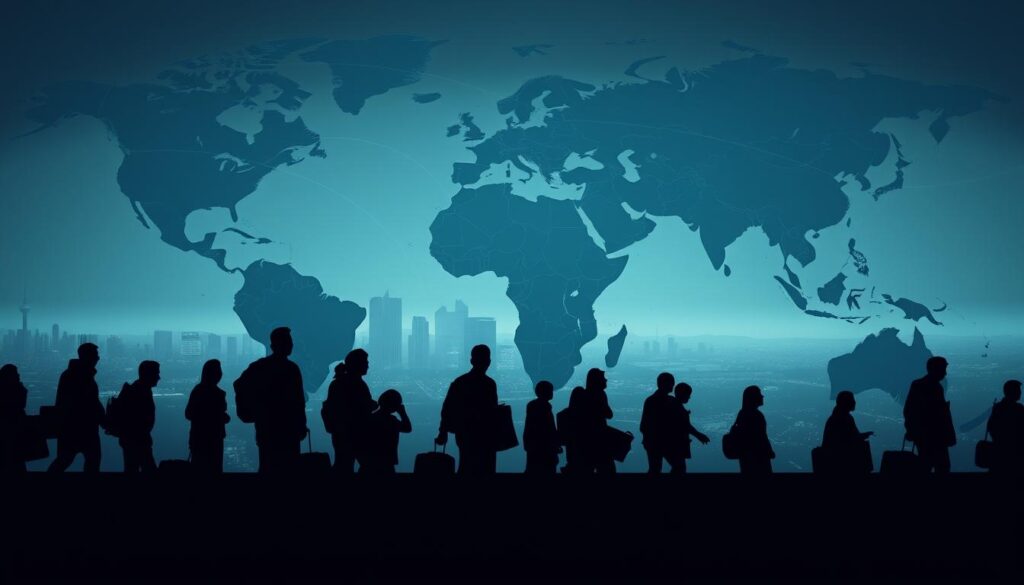
Filipino migrants often chose English-speaking countries. About 73.2% went to places 8,000 to 10,000 miles away. The size of the destination country and its corruption level also mattered.
“The flow of Filipino migration is significantly influenced by the population size of the destination country, with a 1.21 change in migration flow for every unit increase in population.”
This time was the start of the modern Filipino diaspora. OFWs became very important to the Philippines’ economy and the global workforce.
The Rise of Filipino Overseas Workers
The rise of Overseas Filipino Workers (OFWs) has changed the Philippine economy and the global labor market. In 2019, about 2.2 million Filipinos worked abroad, with 59.6% being women. This started in 1972 when President Marcos introduced a policy to boost the economy through labor migration.
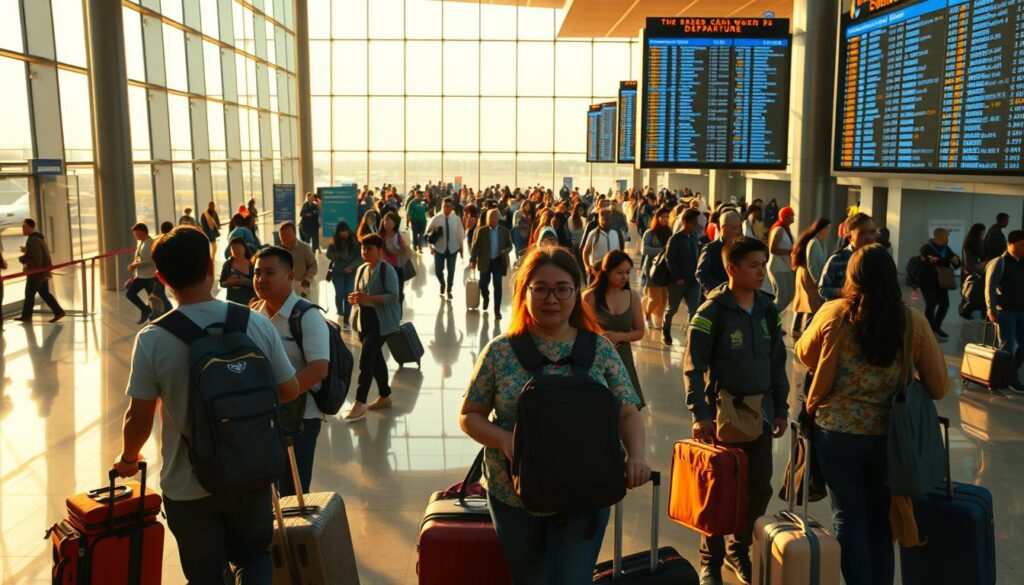
Key Destinations for Filipino Migrants
OFWs are found all over the world, with big numbers in the Middle East, East Asia, and North America. The oil crisis led to more migration to the Middle East. Asian countries and North America also became popular. The Philippines is now the world’s largest supplier of seafarers, with 700,000 Filipino mariners by 2024.
Economic Contributions of OFWs
Filipino remittances are key to the country’s economy. In 2022, OFW remittances added P1.9 trillion (about $37.2 billion) to the Philippine economy, making up 8.9% of the GDP. This foreign currency is crucial for the country’s economic stability.
| Year | OFW Population | Remittances (in USD) | % of GDP |
|---|---|---|---|
| 2019 | 2.2 million | $33.5 billion | 9.3% |
| 2020 | 1.77 million | $29.9 billion | 9.7% |
| 2022 | 1.96 million | $37.2 billion | 8.9% |
The Philippine government has set up agencies like the Philippine Overseas Employment Administration (POEA) in 1978 and the Department of Migrant Workers (DMW) in 2021 to help OFWs. These agencies, along with laws like the Magna Carta of Filipino Seafarers, work to protect the rights and welfare of Filipino workers abroad.
Filipino Migration to the United States
Filipino-American history is filled with waves of migration. Each wave has shaped the Filipino communities in the US. The first Filipino arrived in 1763, but big migrations started in the early 1900s.
Early Migration Patterns
In 1906, 15 Filipino sugar plantation workers arrived in Hawaii. This was the start of a big migration trend. By 1919, over 29,000 Filipinos had moved to Hawaii for work.
These workers, known as Sakadas, were mostly single men. They wanted to save money for education or to better their lives back home.
The 1965 Immigration Act and Its Impact
The 1965 Immigration and Nationality Act changed everything. It made it easier for people to come to the US. This led to more family reunions and skilled workers, like doctors and nurses.
This act also ended the Tydings-McDuffie Act of 1934. That law had limited Filipino immigration to just 50 people a year.
Community Development in the U.S.
Filipino communities grew in many US cities. Workers in sugar plantations, fish canneries, and farms faced tough conditions. They earned as little as $1 a day.
Despite anti-miscegenation laws, these communities became strong. They fought for better working conditions. The 1948 Byron strike and the 1965 Delano Grape Strike were key moments.
| Year | Event | Impact |
|---|---|---|
| 1763 | First recorded Filipino arrival in the US | Beginning of Filipino presence in America |
| 1906 | First group of Filipino laborers arrive in Hawaii | Start of large-scale migration |
| 1965 | Immigration and Nationality Act passed | Increased Filipino migration, specially of professionals |
Filipino Migration to Canada and Europe
The Filipino diaspora has grown a lot in Canada and Europe. It has changed the demographics of these places. Filipino communities are now a big part of their host countries. They help out in many areas of the economy and society.
Canada’s Immigration Policies and Filipino Influx
Canada’s open immigration policies have drawn many Filipinos. By 2016, there were 837,130 Filipinos in Canada, making up 2.4% of the population. This number went up from 662,605 in 2011.
Winnipeg has the most Filipinos, with 9.49% of its people. Toronto and Vancouver also have a lot, with 4.29% and 5.40% respectively. The Live-in Caregiver Program has been a big reason for this migration, with 38,614 Filipinos moving to Canada in 2020.
The Filipino Community in the UK and Beyond
Europe has also seen more Filipinos moving there. By 2005, there were 824,419 Filipinos in Europe. Italy, Spain, and the UK have the biggest Filipino communities. Interestingly, 80% of Filipinos in Europe are women, mostly working in the service sector.
| Country | Filipino Population | Primary Employment Sectors |
|---|---|---|
| Italy | High | Domestic work, Healthcare |
| Spain | Medium | Hospitality, Domestic work |
| UK | High | Healthcare, Service industry |
In 2005, Filipino migrants in Europe sent about $1.4 billion back home. 60% of this came from Italy, the UK, and Germany. These remittances show how Filipino communities help both their host countries and the Philippines.
The Role of Family Reunification in Migration
Family reunification is key in Filipino immigration. In the 1960s, US and Canadian laws changed, making it easier for Filipino families to be together. This led to more Filipinos moving to North America.
Sponsorships and Family-Based Immigration
Family ties became a main reason for Filipinos to move abroad. Between 1971 and 1984, the number of immediate family members allowed to immigrate grew by nearly 150%. Also, the number of immigrants coming through family ties doubled.
| Immigration Category | 1971 | 1984 | Change |
|---|---|---|---|
| Immediate Family Members | 100 (base) | 250 | +150% |
| Family Preference | 100 (base) | 200 | +100% |
| Occupational Preference | 100 (base) | Declined | Significant decrease |
Emotional and Economic Impacts
Family ties play a big role in migration choices. 52% of Filipinos with family in the US moved, compared to 21% without. This shows how family ties drive migration.
The economic benefits of family reunification are clear. 48.4% of Filipino immigrants were sponsored by family. This shows how family ties and economic needs are linked. It helps grow Filipino communities abroad.
The Impact of Globalization on Filipino Migration
Globalization has changed how Filipinos move for work. It has made it easier for them to find jobs in other countries. This has opened up new paths for Filipino workers.
Facilitating Migration in a Global Era
Travel and communication are now easier. This has led to more Filipinos moving abroad. From 1995 to 2017, more Filipinos left their homes to work elsewhere.
Shifting Demographics and Employment Trends
Globalization has made Filipino migration more varied. Fewer Filipinos now go to the U.S. than before. More are moving to the Middle East.
The types of workers moving have also changed. In the 1970s, most were unskilled. By the 2010s, more skilled workers were leaving. This shows Filipino workers are in demand worldwide.
Remittances, or money sent back home, have grown a lot. They went from 2.5% of GDP in 1990 to 9.2% in 2017. This shows how important work abroad is for the Philippines’ economy.
Humanitarian Migration and Displacement
The Filipino diaspora has been shaped by more than just money. Natural disasters and political troubles have also played big roles. These have often forced Filipinos to leave their homes.
Natural Disasters and Forced Migration
The Philippines is hit hard by nature. Typhoons, earthquakes, and volcanoes have caused a lot of people to move. Sometimes, these disasters push Filipinos to look for a new home abroad.
- Over 108.4 million people were forcibly displaced worldwide by the end of 2022
- This includes 35.3 million refugees and 62.5 million internally displaced persons
- 86% of forced migrants are hosted in developing countries
NGOs and Government Responses
Groups and governments are key in helping during crises. They give aid, help people move, and protect their rights. Local governments help follow big plans like the Global Compact for Safe, Orderly and Regular Migration.
The Philippines has a long history of welcoming refugees:
- 800 White Russians fleeing persecution in 1922
- 1,200 Jewish refugees admitted in 1934
- 400,000 Indo-Chinese refugees hosted from 1980 to 1994
This shows the Philippines’ big role in helping worldwide. It shows how forced migration and the Filipino diaspora are connected.
Challenges Faced by Filipino Migrants
Filipino migrants, including Overseas Filipino Workers (OFWs), face many obstacles abroad. These issues range from social and economic problems to legal and political ones. These challenges greatly affect their lives.
Social and Economic Struggles Abroad
OFWs often deal with discrimination and adjusting to new cultures. They often get low-paying jobs with little legal help, even if they’re qualified. A study showed that 54.7% of returned OFWs had irregular jobs, and 18.5% were jobless when they got back to the Philippines.
Language barriers are a big problem, like in healthcare. Filipino migrants in New Zealand said they felt ignored because they didn’t speak English well. They also struggle with cultural differences in medical care and don’t know the healthcare system well.
Legal and Political Issues
Filipino migrant communities face legal and political hurdles. About 10% of Filipino migrants are undocumented, risking jail and losing money. They lack legal protection, making them open to unfair labor practices and exploitation.
Despite these issues, the Philippine government still sees migration as a way to boost the economy. Over 8 million Filipino migrants have gone through government training. Remittances add over 30 billion USD a year to the Philippine economy. But, this comes at a personal cost, like family separation and emotional strain.
The Future of Filipino Migration
Filipino migration patterns are changing, shaping the future of the Filipino diaspora. Global economic shifts and new technologies are set to change the landscape of Filipino overseas employment.
Emerging Trends in Global Migration
The Filipino diaspora, with 10.5 million in 2012, faces new challenges and opportunities. From 2000 to 2013, nearly half of Overseas Filipinos chose permanent migration. This shows a shift towards long-term settlement abroad.
This trend is likely to continue, influenced by economic conditions and immigration policies in host countries.
| Year | Number of Overseas Filipinos | Permanent Migration Rate |
|---|---|---|
| 2012 | 10.5 million | N/A |
| 2000-2013 | N/A | 47-48% |
The Role of Technology in Migration
Technology is changing Filipino migration patterns. Digital platforms offer remote work opportunities, changing overseas employment. The Filipino Channel, making 40% of ABS-CBN’s profits by 2013, shows how migrants transform industries with technology.
As the Filipino diaspora grows, migrants play key roles in advocacy and philanthropy. Organizations like the Philippine International Aid- The Children’s Fund help underprivileged children in the Philippines. The Filipino American National Historical Society works to preserve and reshape cultural narratives.
Conclusion: The Ongoing Journey of Filipino Migrants
The story of Filipino migration is one of strength, change, and keeping culture alive. It started with early trade and now includes the global movement of Overseas Filipino Workers (OFWs). This journey has been influenced by history, economics, and politics.
The Filipino diaspora has made a rich cultural mix around the world. It has greatly affected both the Philippines and countries where Filipinos live.
Reflection on Historical Context and Future Prospects
From 2000 to 2013, the number of Overseas Filipinos grew steadily. These include permanent, temporary, and irregular migrants. The Commission on Filipinos Overseas breaks them down, showing the variety in Filipino migration.
This variety comes from the complex colonial history that shaped Filipino identity and migration.
OFWs face many challenges, like culture shock and homesickness. They also deal with language barriers and adapting to new places. Yet, Filipinos have shown great strength, keeping their culture alive while fitting into new communities.
The Cultural Tapestry of the Filipino Diaspora
The Filipino diaspora has created a colorful cultural mix globally. Digital technology and social media are key in keeping connections and shaping identities abroad. As the world and technology change, so will the Filipino migration story.
This ongoing story highlights the lasting impact of Filipino migration on our global world. It shows how diverse and connected we are.





